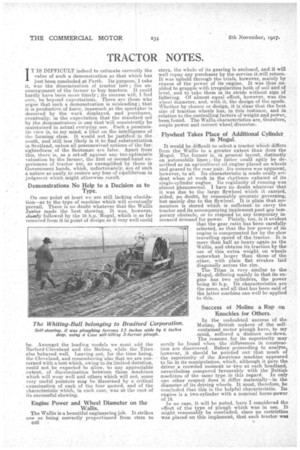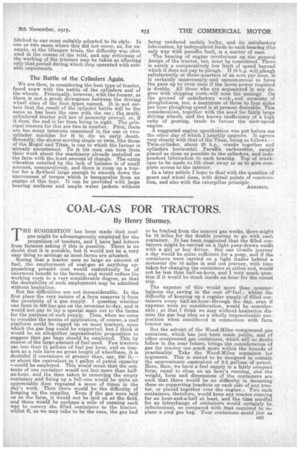TRACTOR NOTES.
Page 12

Page 13

If you've noticed an error in this article please click here to report it so we can fix it.
IT IS DIFFICULT indeed to estimate correctly the value of such a demonstration as that wh ch has just been concluded at Perth. Its purpose, I take it, was the 'dissemination of tractor lore ; the encouragement of the farmer to buy tractors. It could hardly have been more timely ; its success will 1 feel sure, be beyond expectations. There are thotie who argue that such a demonstration is misleadin'
g . that it is productive of harm, inasmuch as the spectator is deceived by the work displayed, and purhhases,
.:I eventually, in the expectation that the stand rd set by the demonstrators is one that will consiste tly be maintained in actual everyday use. Such a p ssimistic view is, to my mind, a libel on the intelligence of the farming class. It would not be justified in the nouth, and still less likely is it to find substantiation in Scotland, unless all preconceived notions of the farr sightedness of the Scotsman are false. Apart from this, there is, as a set-off against any too-optimistic valuation by the farmer, the first or•second-hand experiences of tractor use as exemplified by those in Government hands, which, unfortunately, are bf such a nature as' easily, to restore any loss of equilibrium in judgment which might otherwise result.
Demonstrations No Help to a Decision as to Type.
On one point at least we are still lacking elucida,tion—as to the type of machine which will eventually prevail. There is no doubt whatever that the Wallis Junior made the best showing. It was, however, cloaely followed by the 16 h.p. Mogul, which is as far removed from it in point of design as it very well could be. Amongst the leading models we must add the Burford-Cle.veland and the Moline, while the Titan also behaved well. Leaving out, for the time being, the Cleveland, and remembering also that we are concerned with a test which, owing to its limited duration, could not be expected to allow, to any appreciable extent, of discrimination between those machines which will wear well and others which will not, some very useful pointers may be 'discerned by a critical examination of each of the four named, and of the characteristic which, in each case, was at the root of its successful showing.
Engine Power and Wheel Diameter on the Wallis.
The Wallis is a beautiful engineering job. It strikes one as being correctly proportioned from stem to C4.0 stern, the whole of its gearing is enclosed, and it will well repay any purchaser by the service it.will return. It was upheld through the trials, however, mainly by reason of the power of its engine. It was thus enabled to grapple with irregularities both of soil and of level, and to take them in its stride without sign of faltering. Of almost equal effect, however, was the wheel diameter, and, with it, the design of the spuds. Whether by chance or design, it is clear that the best size of traction wheels has, in this instance, and in relation to the controlling factors of weight and power, been found. The Wallis characteristics are, therefore, ample power and correct wheel, diameter.
Flywheel Takes Place of Additional Cylinder in Mogul.
It would be difficult to select a tractor which differs from the Wallis to a greater extent than does the Mogul. The former is, in general layout, distinctly on automobile lines ; the latter could aptly be described as an agricultural oil engine placed on wheels and geared to the rear pair. Its success was apparent, however, to all. Its characteristic is made orally, evident when at work in the rhythmic exhaust of its single-cylinder engine. Its regularity of running was almost phenomenal. I have no doubt whatever that it was due to the large flywheel which it carried, aided, no doubt, by reasonably accurate governing, but mainly due to the flywheel. It is plain that mo= rnentum is stored which is sufficient to carry the tractor and its accompanying implement past 4ny temporary obstacle, or to respond to any temporary increased demand for power. Plainly, too, is it evident
that the gear ratio haS been carefully ivf selected, so that the low power of its engine is compensated for by the slow travelling speed of the .tractor. It is more than half as heavy again as the Wallis, and obtains its traction by the use of this extra weight on wheels somewhat larger than those of the other, with plain flat strakes laid diagonally across the rim.
The Titan is very similar to the Mogul, differing mainly in that its engine has two cylinders, the power being 20 h.p. Its characteristics are the same, and all that has been said of the latter machine can well be applied to this. .
Success of Moline a Rap on Knuckles for Others.
In the undoubted success of the Moline, British makers of the selfcontained motor plough have, to my mind, suffered a distinct set-down.
The reasons for its superiority may surely be found when the 'differences in construction are discovered. Before proceeding to analyse, however, it should be pointed out that much of the superiority of the American machine appeared to lie in its manipulation, which, although it gave the driver a crowded moment or two at each headland, nevertheless compared favourably with the British machines of the same type in this regarsl. • In only one other respect does it differ materially—in the diameter of its driving wheels. It must, therefore, be concluded that this is the helpful characteristic. Its engine is a two-cylinder with a nominal horse-power of 18.
In no case, it will be noted, have I considered the effect of the type of plough which was in use, It might reasonably be concluded, since no restriction was placed on this implement, that each tractor was hitched to one most suitably adapted to its style. In one or two cases where this did not occur, as, for example, at the Glasgow trials, the difficulty was obviated in the course of the trial, and any criticisms of the 'working .0 the tractors may be taken as affecting only that period during which they operated with suit
able implements. ,
The Battle of the. Cylinders Again.
We are then, in considering the best type of tractor, faced anew with the battle of the cylinders and of the wheels. Principally, however with the former, as there is not .a great divergence between the driving wheel sizes of the four types named. It is not certain that the result of the cylinder battle will be the same as has been the case with the car; the multicylindered tractor will not of necessity prevail, or, if it does, the end is far from being in sight. The principal reasons for this are two in number. First, there are too many interests concerned in the one or twocylinder machine for it to die an early death. Secondly, the slower-moving single or twin, like those of the Mogul and Titan., is one to which the farmer is already accustomed. To it his men can turn from their work about the machinery already installed on the farm with the least amount of change. The extra vibration entailed by the lack of balance is of small account, comparatively, and there is room on a tractor for a flywheel large enough to smooth down the unevenness of torque which is inseparable from an engine of this type. It can be provided with large bearing surfaces and ample water jackets without
being rendered unduly bulky, and its satisfactory lubrication, by independent feeds to each bearing the only way with paraffin fuel), is a matter of ease.
The bearing of engine revolutions on the general design of the tractor, too, must bp considered. There is surely a comparatively low limit of speed beyond which it does not pay to plough.If 13 h.p. will plough satisfactorily at three-quarters of an acre per hour, it is certainly unnecessary, and uneconomical to force the pace up to even time if the horse-power required is double. All those who are acquainted in any degree with shipping costs,will note the analogy. On the ground of satisfactory work and economy of ploughshares, too, a maximum of three to four miles per hour ploughing speed is at present desirable. This consideration, together with the need for fairly large driving wheels, and the known inefficiency of a high ratio of gearing, tends to favour the slow-speed engine.
A suggested engine specification was put before me the other day of which I heartily approve. It agrees very closely with that of the Titan, being as follows :-Twin-cylinder, about 25 h.p. cranks together and cylinders horizontal. Paraffin carburetter, snugly placed as close as possible to the cylinders, and independent lubrication to each bearing. Top of crankcase to be made to lift clear away so as to give complete access to the interior. In a later article I hope to deal with the question of gears and.wheel sizes, with detail points of construction, and also with the caterpillar principle.
AGRIMOT.






















